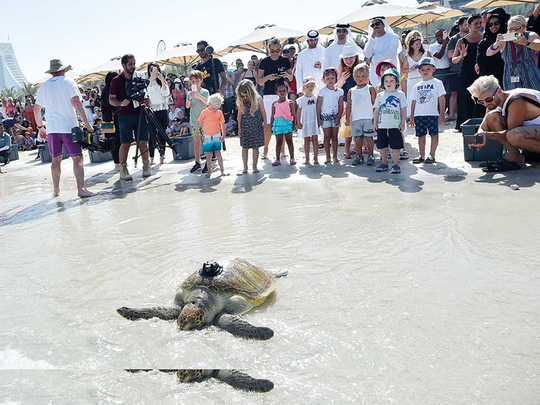
Dubai: For the first time in recent memory in the UAE, a rare olive ridley sea turtle affectionately nicknamed “Barnacle” has been tagged and released back into the wild after being nursed back to good health by the Dubai Turtle Rehabilitation Project.
The unusual specimen was released alongside 70 critically endangered hawksbill turtles on Thursday morning from the Jumeirah Nassem’s rehabilitation lagoon.
About 50 children from Dubai British School were on hand for the release after purchasing a special satellite tag for Barnacle which will enable them to track her progress online as the turtle heads out into Gulf waters.
In a statement on Thursday, Warren Baverstock, Burj Al Arab’s aquarium operations manager, said: “There are very few olive ridleys nesting in Arabia and all of them nest on Masirah Island in Oman. This is the first time an olive ridley has been tagged in the UAE and we are all very excited to discover where she will travel to next. This initiative provides valuable data about how the turtles are progressing in the wild. We are especially gratefully to the local community and the organisations who found many of the injured turtles and brought them to us for rehabilitation.”
Barnacle was rescued several months ago, suffering from positive buoyancy which meant the turtle was constantly floating high up in the water.
After spending time in the turtle rehabilitation facilities at Burj Al Arab Jumeirah, the Dubai Turtle Rehabilitation Project (DTRP) team moved her into the turtle lagoon at Jumeirah Al Naseem and within three weeks she was able to swim down to the bottom.
This latest release brings the total number of turtles returned to the wild since the project began in 2004 to 1,175.
All the turtles had been rescued from the shores of the UAE by members of the public and nursed back to health by the DTRP. The turtles started their rehabilitation at the facilities within Burj Al Arab Jumeirah and were then moved to the new turtle lagoon at Jumeirah Al Naseem before they were released.
The project accepts any distressed turtle, with the most common turtles found in the Arabian Gulf being the critically endangered hawksbill and the endangered green sea turtle. The majority are juvenile hawksbills, which are found washed up on the coast during the winter months of December, January and February suffering from the adverse effects of cold sea temperatures.












